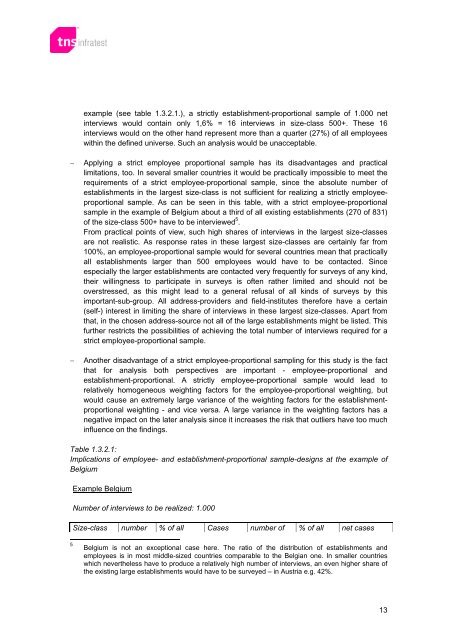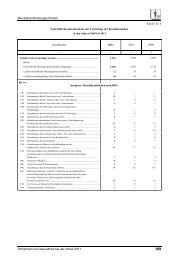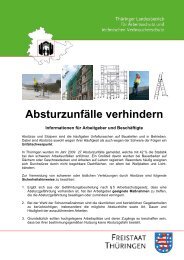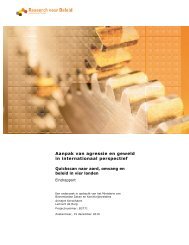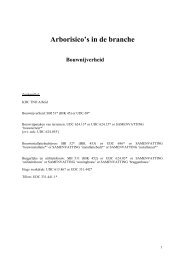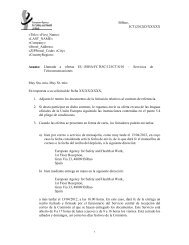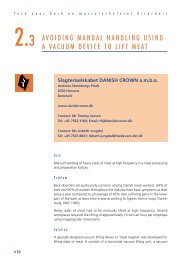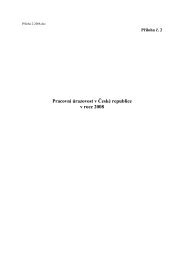ESENER-PSR 2009 - European Agency for Safety and Health at Work
ESENER-PSR 2009 - European Agency for Safety and Health at Work
ESENER-PSR 2009 - European Agency for Safety and Health at Work
Create successful ePaper yourself
Turn your PDF publications into a flip-book with our unique Google optimized e-Paper software.
example (see table 1.3.2.1.), a strictly establishment-proportional sample of 1.000 net<br />
interviews would contain only 1,6% = 16 interviews in size-class 500+. These 16<br />
interviews would on the other h<strong>and</strong> represent more than a quarter (27%) of all employees<br />
within the defined universe. Such an analysis would be unacceptable.<br />
Applying a strict employee proportional sample has its disadvantages <strong>and</strong> practical<br />
limit<strong>at</strong>ions, too. In several smaller countries it would be practically impossible to meet the<br />
requirements of a strict employee-proportional sample, since the absolute number of<br />
establishments in the largest size-class is not sufficient <strong>for</strong> realizing a strictly employeeproportional<br />
sample. As can be seen in this table, with a strict employee-proportional<br />
sample in the example of Belgium about a third of all existing establishments (270 of 831)<br />
of the size-class 500+ have to be interviewed 5 .<br />
From practical points of view, such high shares of interviews in the largest size-classes<br />
are not realistic. As response r<strong>at</strong>es in these largest size-classes are certainly far from<br />
100%, an employee-proportional sample would <strong>for</strong> several countries mean th<strong>at</strong> practically<br />
all establishments larger than 500 employees would have to be contacted. Since<br />
especially the larger establishments are contacted very frequently <strong>for</strong> surveys of any kind,<br />
their willingness to particip<strong>at</strong>e in surveys is often r<strong>at</strong>her limited <strong>and</strong> should not be<br />
overstressed, as this might lead to a general refusal of all kinds of surveys by this<br />
important-sub-group. All address-providers <strong>and</strong> field-institutes there<strong>for</strong>e have a certain<br />
(self-) interest in limiting the share of interviews in these largest size-classes. Apart from<br />
th<strong>at</strong>, in the chosen address-source not all of the large establishments might be listed. This<br />
further restricts the possibilities of achieving the total number of interviews required <strong>for</strong> a<br />
strict employee-proportional sample.<br />
Another disadvantage of a strict employee-proportional sampling <strong>for</strong> this study is the fact<br />
th<strong>at</strong> <strong>for</strong> analysis both perspectives are important - employee-proportional <strong>and</strong><br />
establishment-proportional. A strictly employee-proportional sample would lead to<br />
rel<strong>at</strong>ively homogeneous weighting factors <strong>for</strong> the employee-proportional weighting, but<br />
would cause an extremely large variance of the weighting factors <strong>for</strong> the establishmentproportional<br />
weighting - <strong>and</strong> vice versa. A large variance in the weighting factors has a<br />
neg<strong>at</strong>ive impact on the l<strong>at</strong>er analysis since it increases the risk th<strong>at</strong> outliers have too much<br />
influence on the findings.<br />
Table 1.3.2.1:<br />
Implic<strong>at</strong>ions of employee- <strong>and</strong> establishment-proportional sample-designs <strong>at</strong> the example of<br />
Belgium<br />
Example Belgium<br />
Number of interviews to be realized: 1.000<br />
Size-class number % of all Cases number of % of all net cases<br />
5 Belgium is not an exceptional case here. The r<strong>at</strong>io of the distribution of establishments <strong>and</strong><br />
employees is in most middle-sized countries comparable to the Belgian one. In smaller countries<br />
which nevertheless have to produce a rel<strong>at</strong>ively high number of interviews, an even higher share of<br />
the existing large establishments would have to be surveyed – in Austria e.g. 42%.<br />
13


